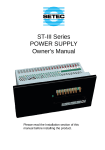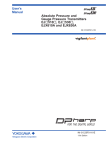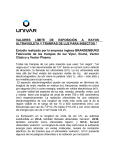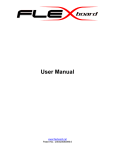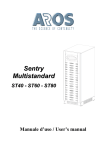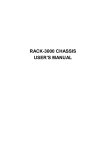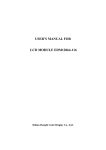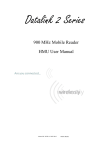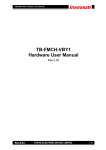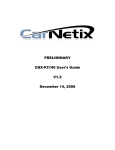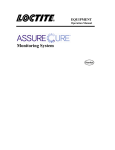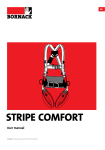Download ST Series User Manual
Transcript
ST Series POWER SUPPLIES USER INSTRUCTIONS Introduction These instructions detail the installation and operation requirements for the ST20 & ST35 power supplies. These have been designed for operation in RV’s providing a DC power system, with optional battery back up. The units operate from 240Vac and provide an isolated 13.65Vdc output at 20A and 35A respectively for powering the load and charging of batteries. All the necessary protection and operating features for the load and batteries are provided. An optional DC input is also provided to enable charging of batteries and powering of the load from an external +13.8V dc power source. The units are fully enclosed ready for direct wall mounting. All connections are at the rear of unit providing convenient wiring and installation. User access to all load and battery fusing has been provided from the front of the unit. Operation Safety: Refer to the installation section before operating. Correct installation is the most critical factor in ensuring the safe use of the power supply. If every consideration of these instructions has been satisfied the power supply will be safe to operate. Functional Diagram: Fuse Panel DC External Input +ve AC / DC Power Supply 5 x Load Outputs -ve AC Input Vadj Isense Battery Low Voltage Disconnect circuit 1.2A Trickle +ve Battery Output -ve Figure 1 Functional Block Diagram AC/DC Power Supply: This provides an isolated 13.65Vdc output for powering of the load and float charging of the battery. Battery current is sensed and monitored by the power supply to ensure that the maximum charging current is not exceeded. Battery Features: The power supply provides automatic battery operation of the following. Charging current is limited to a maximum of 5A (ST20) and 10A (ST35). This provides optimum life for the batteries. To charge at the maximum battery charge current above, ensure the load current plus battery current is equal or less than the maximum output current. The charging current will be reduced in situations Page 1 of 7 7982 ST Series POWER SUPPLIES USER INSTRUCTIONS were the difference between the rated output current and the load current (the available charging current), is less than the maximum charging current. Also note that the battery current sense is provided in the “-ve” battery output. For this feature to work, the load and battery “-ve” should not be cross connected. (Appliances connected to the chassis must also be taken into consideration. ie if the battery is connected to the chassis, then cannot have an appliance with its “–ve” connected to the chassis) Low Voltage Disconnection of the batteries is provided to prevent deep discharge of the battery. Automatic reconnection occurs when battery voltage recovers. Battery Current Drain is always present. The battery should be isolated if the unit is not in regular use. See specifications for details. Trickle Charge to the battery is always present. When the battery voltage is below the LVD reconnect voltage (<9V) and the mains power is available, the battery will be charging at 1.2A. When the battery voltage sufficient (>9V) the LVD will connect the battery and allow float charging at 5A/10A (ST20/ST35). This feature is provided to allow “very” flat batteries to be charged at a rate, which will extend their life. External Input Voltage: This provides an alternative option for powering of the load and float charging of the batteries when mains voltages are not present. This input is to be powered by a suitable +12V system. (ie CAR or SOLAR cells with regulator). When operating via the external input, current and voltage control for the battery must be provided from the external source. The ST20/35 does not provide battery current limit or voltage control when operating in this configuration. Suitable fuse protection must be provided for this input. Protection: the power supply provides automatic protection for overload including short circuit, over-voltage, over-temperature and reverse connected battery. In such instances the Fault indicator will illuminate and the power supply will shut down. It will attempt to automatically restart every 5 seconds until such case that the fault is removed. Fusing: Each load circuit and the battery have been fused to provide fault protection and discrimination. Refer to servicing section for maximum fuse ratings. CAUTION: This appliance is not intended for use by young children or infirm persons without supervision. Young children should be supervised to ensure that they do not play with the appliance. Page 2 of 7 Issue F ST Series POWER SUPPLIES USER INSTRUCTIONS Installation Host Equipment: The host equipment must ensure that access to the unit (other than the front panel) by the user is prevented. Personnel: Installation is to be carried out only by suitably qualified personnel. Ventilation: Provide a minimum of 80mm clearance above and below the unit. The final enclosure must also provide adequate ventilation to the outside world (or larger internal cavity) to prevent the build up of hot air. Failure to provide adequate ventilation will mean the unit may prematurely trip thermal shutdown. The ST35 unit utilizes an internal fan (thermally controlled), which intakes air from the left hand side of the unit. A clearance of 50mm is required to this surface of the power supply. CAUTION Do not install unit in same compartment as batteries or flammable material such as petrol. Mechanical and Mounting: 303.5 Four by 4.5 x 9mm mounting holes at 129.5 (h) x 287 (w) centres. Fuse Panel Door 156.5 111 222 Fault LED 333 444 555 B A B ATTT BA Cut out for mounting 152(h) x 272(w) Depth of unit is 125mm After mounting unit, clip on the front fascia (ensure that all locking clips have engaged) and secure with screw located inside the fuse panel door. Orientation: The unit is to be installed with the front fascia in a vertical plane. Failure to do this will cause premature temperature shutdown. Page 3 of 7 Issue F ST Series POWER SUPPLIES USER INSTRUCTIONS Wiring Up Mains: This is pre cabled and fitted with AS/NZ mains plug ready for connection to internal GPO. Ensure that the connection to the mains supply is in accordance with the national wiring rules, and that the earth connection is installed. Load, Battery and External DC Input Connections: Connectors are 0.8 x 6.3mm QC tabs. Use mating QC connector suitable for cable size. Connector pin-out is shown below. F1 L- L1+ CAUTION Load 1 F2 Do not cross connect L- to VBATT-. Doing so will disable the battery current limit feature. L- L2+ Load 2 L- L3+ F3 Load 3 L- L4+ F4 Vext+ must be supplied from a fused (Fext), external voltage. Load 4 L- L5+ F5 Load 5 To LVBATT+ VBATT- FBATT Vext + Fuse Panel Fext +ve terminals + To External Voltage -ve terminals plus Vext+ input. Cabling sizes: DC cables must be sized to carry the maximum full load current and not exceed the system volt drop requirements. The following cable sizes are recommended. Current 0 -10 A 10 - 20 A 20 - 30 A AWG 18 14 10 mm2 1.0 3.0 5.5 Were cables pass thru any part of a metal panel or cover, ensure that a cable gland or bush is fitted to the hole. Page 4 of 7 Issue F ST Series POWER SUPPLIES USER INSTRUCTIONS Batteries When using batteries with this product always consult with the battery manufacturer for a detailed description of the installation, use and maintenance of the battery manufactures specific batteries. This product is suitable for charging 12V lead-acid batteries. Charging current is limited to 5A (ST20) and 10A(ST35). CAUTION: Ensure that there is good ventilation from the battery area. Ensure that cable connections to batteries have the correct polarity and are protected against accidental short circuit. Ensure that the shrouding supplied with the battery is fitted to the terminals Provide visual notification that batteries are being used in area of use. Before servicing a battery, disconnect the power supply. Batteries are electrically alive at all times and must be treated with extreme caution. They can supply high short circuit currents, even if they appear damaged. Take care that dropping our touching of metal objects onto the battery cell does not cause short circuits. Remove any personal metal adornment such as a chain, watch or ring, which could cause short circuits and personal injury. Servicing Personnel: This product contains hazardous voltages and energy hazards, which can result in death or injury. Only properly qualified service personnel may service it. There are no internal user serviceable parts. Only the fuses located in the “fuse panel” located on the front panel are serviceable. Isolate mains power, Vext and battery before servicing. Replacement of Fuses: Only the DC output Load and Battery fuses may be replaced. Fuse ratings: Load fuses 20A max, Battery Fuse 35A max. Fuse types: 32V Automotive Bussmann ATC series or Littelfuse 257 series or equivalent Page 5 of 7 Issue F ST Series POWER SUPPLIES USER INSTRUCTIONS Specification Input Voltage: ST20: 220 – 240Vac nominal, ±10%, 50/60Hz. ST35: 230 – 240Vac nominal, ±10%, 50/60Hz. The power supply will withstand a 5 minute, +15% surge on the maximum nominal voltage Input Surge: < 40A (cold start) Holdup Time: > 10mS at full load current and over nominal input voltage operating range Output Current: ST20: 20A Continuous (load + battery current) ST35: 35A Continuous (load + battery current) Factory Set Voltage 13.65V +/- 0.1V Load Regulation: < 2% Output Ripple Voltage: < 100mV Over Voltage Protection: < 17V Over Current Protection ST20: 20A to 25A (load + battery current) ST35: 35A to 38A (load + battery current) Battery Current Limit 5A ± 1A (ST20) 10A ± 1A (ST35) Battery Disconnect Connect: 11.65 ± 0.3V (Input Mains not present) Connect: >9.0V (Input Mains present) Disconnect: 10.5 ± 0.3V Hysteresis: 1.1V (typ) Battery Trickle Charge 1.2A Battery Drain LVD closed: < 250mA @ 12V. LVD open: < 10mA @ 12V. Efficiency: ST20: > 84% ST35: > 88% Ambient 0OC – 50OC Weight: < 2kg Standards Safety: EN60335-1 & EN60335-2-29 EMC EN55022 class B Compliance: OCEI, ACA (RCM) Page 6 of 7 Issue F ST Series POWER SUPPLIES USER INSTRUCTIONS Electromagnetic compatibility (EMC) Electromagnetic compatibility (EMC) is defined as “the ability of a device, equipment or system to function satisfactorily in its electromagnetic environment without introducing intolerable electromagnetic disturbance to anything in that environment”. Switch-mode power supplies are good generators of EMI and as such care needs to taken during their designs to limit their emissions. Requirements of the local regulator (ACA) limit the emissions to protect the frequency spectrum. Limits are set down in standards such as EN55022 for radiated and conducted emissions. However, these limits are not satisfactory for devices in close proximity (<3m) and as such do not guarantee that the power supply will not cause interference with devices such as TV’s or radios. The ST20/35 have been designed with equipment interoperability in mind. The emissions are in the order of 10 – 100 times below the regulator requirements (this is expressed in dB (uV)) and greatly reduce the likelihood of causing interference with Radios and TV’s located in close proximity. 5MHz 0.15MHz 30MHz EN55022 Class B Limit AM Band 30dB Margin ST20/35 Conducted Emissions However, care still needs to be taken with the routing of cables and placement of the unit with respect to appliances. Small emissions can still cause interference. If interference is present, then locate cables from the power supply away from appliance so far as possible and also locate the power supply away as far as practical. Page 7 of 7 Issue F







